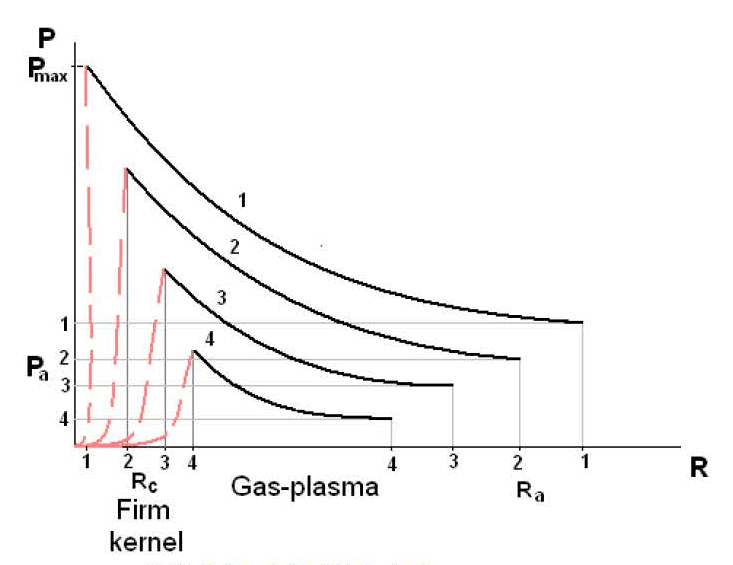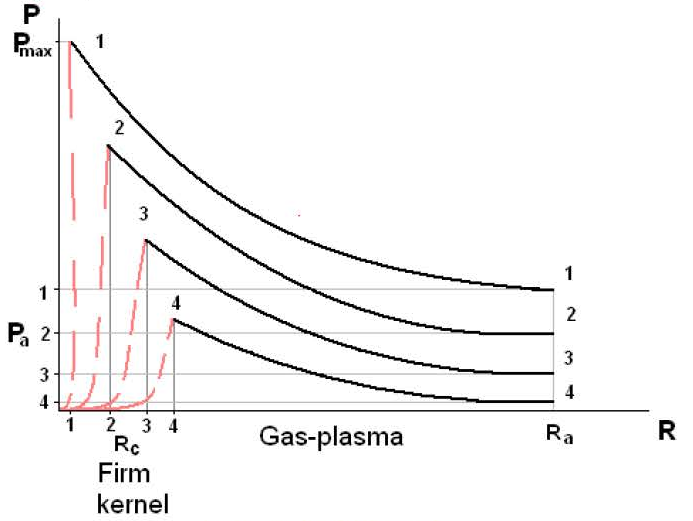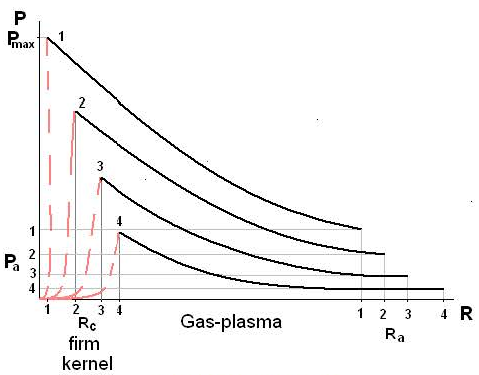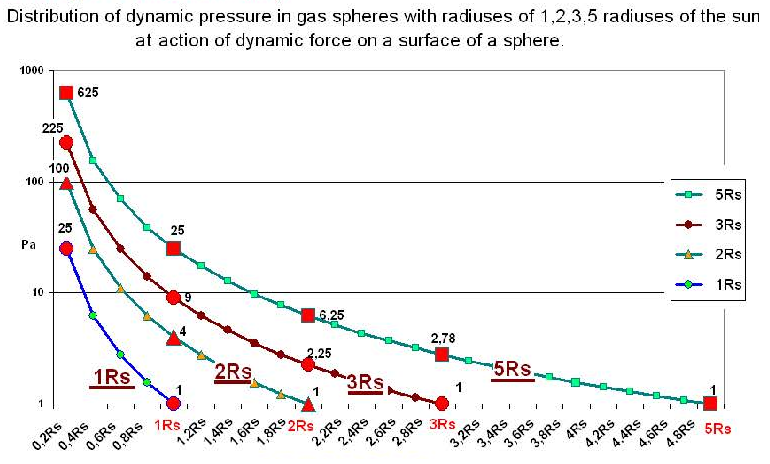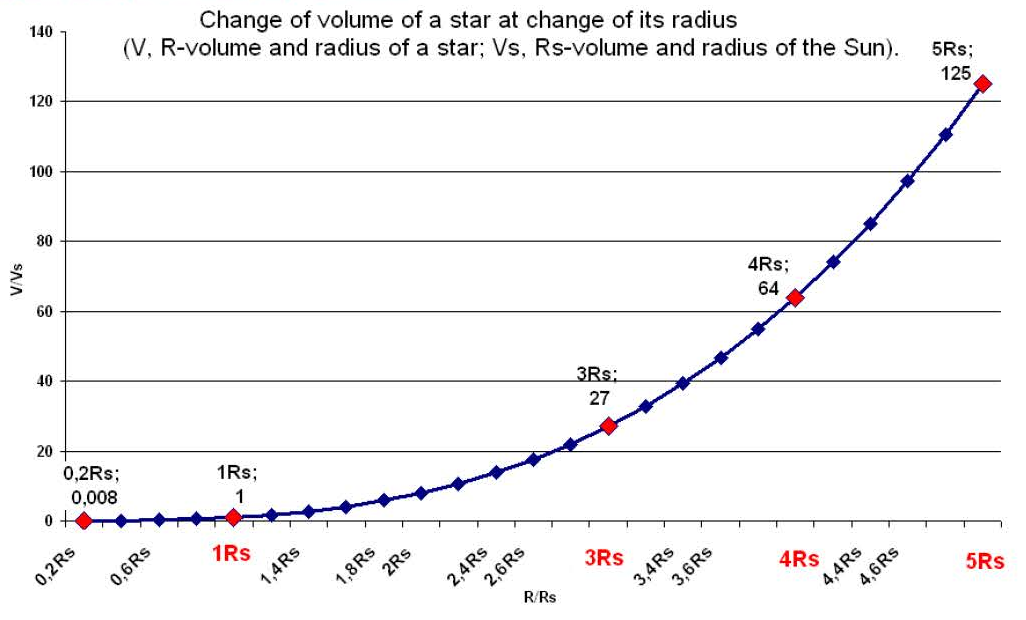In the solid nucleus most of the load take on layers which are closer to the surface with the approach to center of the nucleus load decreases to minimum values.
Possible variants of changes in the distribution of pressure the star throughout the life are shown in the graphs № G-2.4a, № G-2.4b, № G-2.4c.
The line — 1 characterizes the distribution of pressure in the star at the beginning of life, 2 and 3 — in the middle of life, 4 — at the end of a star’s life.
(15) Schedule №G-2.4a
On the schedule №G-2.4a a prospective change of pressure in a star is represented, at a decrease in capacity of allocated energy and reduction of its radius during a life. Apparently from the schedule, the volume and pressure in gas decreases, while the volume of a firm kernel increases.
On the schedule №G-2.4b a prospective change of pressure in a star is represented, at a decrease in capacity of allocated energy during the life under the condition that the radius of the star does not change. As, there is a probability, that gas being the compressed state inside of a star, at decrease in allocation of energy and pressure decrease of compression, tries to extend and borrow all volume, That means, to aspire, to restoration of the sizes of a star.
(16) Schedule №G-2.4b
(17) Schedule № G-2.4c
On the schedule № G-2.4c prospective change of pressure in a star is represented, at decrease in capacity of allocated energy, during a life, the radius of a star increases. As there is a probability, that at a decrease in allocation of energy on the surface of a star and decrease in the dynamic pressure, the gas tries to extend and increases the volume, hence, the volume of the star also extends.
The variants disassembled and schedules by us are the variants of possible physical events, whose possible existence, requires serious scientific studying.
Let’s consider the dependence of change of dynamic pressure in the star’s sizes, under the condition that the dynamic pressure upon the surfaces stars considered by us is identical and is equal 1Pa. We shall consider cases when the radius of a star we’re interested in is equal: 1Rs — to one radius of the Sun; 2Rs — to two radiuses of the Sun; 3Rs-to three radiuses of the Sun; 5Rs-to five radiuses of the Sun (Rs — radius of the Sun).
(18) Schedule № G-2.5
We have calculated the changes of pressure at different levels, and the schedule №G-2.5 has been constructed by the results of these calculations. It is visible from the given schedule that at increase in radius of a star, the dynamic pressure in its bowels, increases in square dependence. So, a star with radius twice has more than radius of the Sun, at a level of radius of the Sun, the pressure will be twice more, than on a surface of the Sun. At the radius of a star in three solar radiuses, the pressure increases up to nine solar. At the radius of star in five solar radiuses, the pressure is up to twenty five.
At a level of 0.2 solar radiuses, where the pressure in a star with radius of the Sun increases in 25 times, the pressure in a star with radius twice more than solar — the pressure increases by 100 times. In a star with three radiuses of the Sun — the pressure is by 225 times higher, and in a star with five radiuses of the Sun — pressure is higher by 625 times. That means, with the increase in radius of a star, the pressure of compression of its bowels, in square dependence that increases speed of synthesis of kernels increases, and increases the probability of synthesis of heavy kernels.
The increase in the sizes of a star influences the speed of synthesis not only due to increase in pressure in a star, but also due to increase in volume of the star that allows to increase the quantity of kernels participating in synthesis. The given increase already has cubic dependence as shown in the schedule №G-2.6. So, the increase in radius of a star in 3 times, increases the volume of a star in 27 times, at increase in radius of a star in 4 times, the volume increases in 64 times, at increase by 5 times, the volume increases by 125 times.
Hence, at increase in sizes of a star, by pressure of compression of a matter in its bowels and by quantity of by matter that leads to increase in by speed of synthesis of kernels and to increase in by synthesis of heavier kernels. The increase in speed of synthesis in a star reduces its time of a life, and increases by quantity of heavy kernels, approaching their weight up to «critical». At stars with greater weights, the quantity of heavy kernels exceeds «critical» weight, which leads to a nuclear explosion (to a collapse) of stars.
(19) Schedule №G-2.6
It is probable, that particularly the increase in the volume of a star and pressure in it, during the increase of its sizes, reduces time of life of a star, and the reason for the accumulation of heavy kernels of atoms in the kernel of the star (in «the white dwarf») that leads to a collapse at heavy stars.
From the analysis lead to this section, it is possible to draw a conclusion, that the form of the star — a sphere, is capable to concentrate and strengthen power processes.
We have considered the surprising peculiarities of the spherical form. Such design of a star, as a nuclear reactor, promotes the synthesis of practically any elements of the periodic table, and possibly even of the over heavy kernels of atoms, which goes beyond the aisles of the periodic table and cannot exist in terrestrial conditions.


